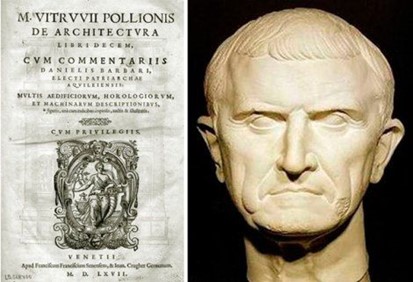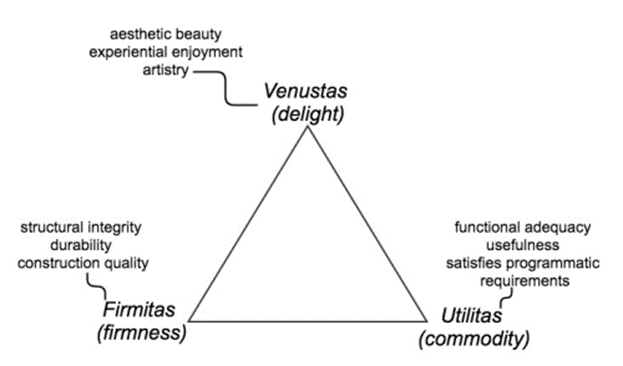3 min read
What Motivates Architects. Clue: It’s Probably Not What You Think
![]() Paul Iddon
:
12-Aug-2021 13:15:00
Paul Iddon
:
12-Aug-2021 13:15:00

A post written by architect and friend of Insynth, Paul Iddon ARB RIBA.
Believe it or not, the definition of what architecture actually ‘is’ hasn’t changed in over 2000 years.
In another blog, I talk about the driving idea of Modern Movement Architecture(1) from the beginning of the 20th century that still shapes our built environment. But beneath every style and school of architecture, including Modernism, there is a more fundamental philosophy that has persisted since biblical times
Three Concepts That Motivate Architects
No one has come up with anything that comes close to such beautiful simplicity. It is Pythagoras’s theorem of architecture.
If you listen closely to any architect talking about their work, you will perceive a pattern. In essence, when they describe a project, it can be always broken down into three key concepts. In fact, I am so confident that this is the case, after you have read this piece, I invite you to try it for yourself.
If you want a pocket-sized definition of what motivates architects the world over, it boils down to three concepts defined by Marcus Vitruvius Pollio(2) in 15 BCE.

Marcus Vitruvius Pollio – Roman architect and military engineer 80-15 BCE
A Roman architect, civil and military engineer, he worked during the reign of Emperor Augustus and served under Marcus Agrippa (who worked to make Rome into ‘a city of marble’). The thesis in ‘Ten Books on Architecture’ was ‘rediscovered’ during the renaissance and became the cornerstone of architecture.
Known as the ‘Vitruvian Virtues or Vitruvian Triad’, the Latin words: firmitatis, utilitatis, venustatis defined the three qualities Vitruvius believed every structure should possess(3).
Translations differ slightly, the most common version being: Commodity, Firmness and Delight.
 Courtesy of McMansionhell 2021
Courtesy of McMansionhell 2021
These three words still largely underpin architect motivations to this day. In a way, they are kind of an equivalent of a ‘Hippocratic Oath’ for the profession. So, what do they mean?
Commodity – appropriate design of spatial accommodation and setting on the site, i.e. good planning.
Firmness – Stability and build quality i.e. excellence in detail and construction.
Delight – Beauty and attractiveness in appearance.
This third quality is the difference between what an architect would describe as ‘building’ i.e., commodity and firmness, and ‘architecture’.
Put simply, ‘There is no architecture without delight’, a statement that is definitely worth putting on a tee-shirt.
The Synthesis of Form
Many people think architects are driven by ‘design’, but that’s only part of the story. The truth is far more complicated. The three principles are the driving force of both architects and architecture and turbocharge the built environment. It is been described as the ‘synthesis of form’.
This all may sound somewhat philosophical and even esoteric, but it is very real. Think about the places people travel huge distances to visit. They are drawn to witness first-hand, some of the most extraordinary of human achievements.
The Sagrada Familia in Barcelona by Antonio Gaudi, the Cathedral of Santa Maria del Fiore in Florence with its amazing dome by Filippo Brunelleschi. Or the iconic Sydney Opera House by Danish architect Jørn Utzon. They sense something fundamental to the human spirit, a sense of rightness. This is what Vitruvius was talking about and architects strive toward, no matter how ‘every day’ the project might seem.
 Courtesy of Wikipedia 2021 Sagrada Familia by Antonio Gaudi 1883-present, Barcelona, Spain
Courtesy of Wikipedia 2021 Sagrada Familia by Antonio Gaudi 1883-present, Barcelona, Spain

Courtesy of Wikipedia 2021 Duomo, Cathedral of Santa Maria del Fiore by Filippo Brunelleschi 1436, Florence, Tuscany, Italy
 Courtesy of Wikipedia 2021 Sydney Opera House by Jørn Utzon 1973 Sydney, New South Wales, Australia
Courtesy of Wikipedia 2021 Sydney Opera House by Jørn Utzon 1973 Sydney, New South Wales, Australia
Vitruvian principles, whether consciously or not, drive any architect ‘worth their salt’ (another roman reference – the word salary is derived from the Latin for salt). In reality, it is what fundamentally motivates them.
You can take any building or structure today and define its success or failure by these three principles. But making it happen is entirely another matter. It is extremely difficult and also why it takes any architect so many years to master – far more than the official seven years of training to earn the title. You can go further and say that the true test of an architect’s ability lies in their understanding and interpretation of them.
Conclusion
It’s not a bad idea to think about how your product or service fits into the architect’s world – do they possess the same three virtues? Does your communication convey similar principles? Does it communicate simply, in a well-structured format that is pleasing to the eye? Is it well planned, effective in its detail and feels satisfying?
If it does to you, it should to your architect audience.
Put another way, is the whole greater than the sum of its parts? This is far from simple as any marketer knows. But if it does meet these criteria, you are well on the way to getting under the skin of your audience.
If it doesn’t, there may be a fundamental issue and the message might be lost or confused in their perception.
Fittingly, the last word should be given to another famous Roman Emperor and Stoic philosopher, Marcus Aurelius Antoninus. Best known for his book ‘Meditations’(4) (definitely worth a read with a nice Chianti) but in this instance, via a quote by Dr. Hannibal Lecter from ‘Silence of the Lambs’(5).
“First principles, Clarice. Simplicity. Read Marcus Aurelius. Of each particular thing, ask what is it in itself? What is its nature? What does he do, this man you seek?”
Paul Iddon ARB RIBA
© Paul Iddon 2021
About Insynth
At Insynth we deliver a predictable flow of leads, customers, and specifications for building product brands through our inbound marketing approach, proven to reach a technically demanding audience.
We use the latest marketing techniques such as construction inbound marketing, to equip building product companies to grow sustainability in this era of digital transformation.
As the only HubSpot certified agency to major in construction marketing. We have a proven formula of bringing a variety of functionalities together including CRM Implementation, Web Design, Sales Automation, SEO, and Email Marketing to achieve your ultimate aim: Growing your business and gaining new specifiers and customers.
Book A Free Consultation Today


